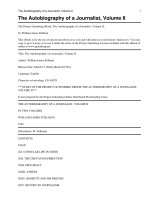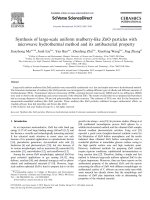Visualization of large medical volume data
Bạn đang xem bản rút gọn của tài liệu. Xem và tải ngay bản đầy đủ của tài liệu tại đây (6.26 MB, 147 trang )
VISUALIZATION OF LARGE
MEDICAL VOLUME DATA
NGUYEN PHU BINH
(B.Eng., M.Sc., Hanoi University of Technology)
A THESIS SUBMITTED FOR THE DEGREE OF
DOCTOR OF PHILOSOPHY
DEPARTMENT OF ELECTRICAL AND COMPUTER
ENGINEERING
NATIONAL UNIVERSITY OF SINGAPORE
2012
Declaration
I hereby declare that the thesis is my original work and it has been written by me
in its entirety. I have duly acknowledged all the sources of information which have
been used in the thesis.
This thesis has also not been submitted for any degree in any university previously.
Nguyen Phu Binh
27 June 2012
iii
Acknowledgements
Many people, in one way or another, have helped to make this dissertation a
reality. I can only mention a few of them here.
First and foremost, I wish to express my deep gratitude to my supervisor, Assoc.
Prof. ONG Sim-Heng, for letting me be one of your students, and guiding me
along my Ph.D. study. Without your insights and comments, this dissertation
and other publications of mine would not have been possible. Thanks for your
understanding, patience, and belief in me.
I would like to sincerely thank my co-supervisor, Dr. CHUI Chee-Kong, who first
sparked my research interest in the field of scientific visualization. Thanks for your
guidance, understanding, encouragement, and most importantly, your friendship
during my study in Singapore. For everything you have done for me, I can say
that I am very lucky to know you, to be your student, and to work with you.
My thanks also go to Dr. Stephen CHANG for providing me a number of medical
image datasets for my research, and giving me useful advices from a senior sur-
geon’s point of view. I have gained a lot of knowledge from discussing with you,
not only in medicine, but also in other fields.
v
Acknowledgements
Special thanks to all group members, especially ZHANG Jing, QIN Jing, LI Bing
Nan, YANG Tao and TAY Wei-Liang, for your friendship and assistances. Thank
you, YANG Liangjing, for helping me a lot with my writings. Thanks to HAN
Thanh Trung for giving me invaluable advices in doing research.
I would like to acknowledge the financial, academic and technical supports from
the ASEAN University Network and the Southeast Asia Engineering Education
Development Network Project (AUN/SEED-Net). I believe you will be successful
in promoting human resource development in engineering in ASEAN.
During our time living in Singapore, I and my family receive a lot of help from
our friends. I wish to express my appreciation to Dominic ANG, my first and best
Singaporean friend, who have helped us since the first day we came to Singapore.
I still remember the night you stayed with us in NUH when my son was sick.
Thanks for helping and always being with us during our hard times.
I wish to thank my best friend since primary school, DO Quoc Anh, who is cur-
rently an Assist. Prof. in Singapore Management University, for your comradeship
and support. I wish you and Kieu Trang all the success on your way ahead.
I and my family are grateful for the company of our neighbors in PGP and other
Vietnamese friends in NUS. Special thanks to Mr & Mrs Tuan & Cuc, Dat & Ha,
WANG Shuai & Lili, Thang & Quyen, and Phong & Huong for sharing memorable
times with us.
Last but not least, I would like to thank all of our family members for their love,
encouragement, and sacrifice. I am deeply thankful to my parents who raised me
and supported me in all my pursuits, to my parents-in-law and my mother who
spent time in Singapore to support us and help us look after our son; and to my
vi
Acknowledgements
younger brother, NGUYEN Viet Anh, for helping me take charge of all family
matters when I am away from home.
This dissertation is dedicated to my loving wife, DO Thi Thu Trang, who always
expresses her endless support, inspiration and faith in me, and my son, NGUYEN
Minh Duc, who has gone abroad and shared a Ph.D. life with his parents since he
was just 5-month-old. I love you both with all my heart.
vii
Contents
Declaration iii
Acknowledgements v
Summary xiii
1 Introduction 1
1.1 Medical Volume Data . . . . . . . . . . . . . . . . . . . . . . . . . . 1
1.2 Compression and Visualization of Medical Volume Data . . . . . . . 3
1.3 Dissertation Objectives and Organization . . . . . . . . . . . . . . . 5
2 Dynamic Medical Volume Data Rendering 9
2.1 Related Methods . . . . . . . . . . . . . . . . . . . . . . . . . . . . 10
2.2 Clustering-based Volume Rendering Method . . . . . . . . . . . . . 12
2.2.1 Clustering . . . . . . . . . . . . . . . . . . . . . . . . . . . . 12
2.2.1.1 BIRCH-based Clustering . . . . . . . . . . . . . . . 13
2.2.1.2 Clustering Granularity . . . . . . . . . . . . . . . . 17
2.2.1.3 Output Data . . . . . . . . . . . . . . . . . . . . . 18
2.2.2 Rendering . . . . . . . . . . . . . . . . . . . . . . . . . . . . 19
2.3 Results and Discussion . . . . . . . . . . . . . . . . . . . . . . . . . 21
ix
CONTENTS
2.4 Summary . . . . . . . . . . . . . . . . . . . . . . . . . . . . . . . . 29
3 Dynamic Medical Volume Data Compression for Visualization 31
3.1 Related Methods . . . . . . . . . . . . . . . . . . . . . . . . . . . . 32
3.2 Compression Scheme . . . . . . . . . . . . . . . . . . . . . . . . . . 36
3.3 Three-Dimensional Image Compression using Hierarchical Vector
Quantization . . . . . . . . . . . . . . . . . . . . . . . . . . . . . . 38
3.4 Three-Dimensional Motion Estimation and Compensation . . . . . 41
3.4.1 Novel Block Distortion Measure . . . . . . . . . . . . . . . . 43
3.4.2 Novel 3-D Motion Estimation Algorithms . . . . . . . . . . . 44
3.5 Experiments . . . . . . . . . . . . . . . . . . . . . . . . . . . . . . . 49
3.6 Results and Discussion . . . . . . . . . . . . . . . . . . . . . . . . . 57
3.7 Summary . . . . . . . . . . . . . . . . . . . . . . . . . . . . . . . . 65
4 Transfer Function Design for Medical Visualization 67
4.1 Related Methods . . . . . . . . . . . . . . . . . . . . . . . . . . . . 68
4.2 Transfer Function Design System . . . . . . . . . . . . . . . . . . . 72
4.2.1 Automatic TF Design using Two-step Clustering . . . . . . 72
4.2.2 Automatic TF Design using Three-step Clustering . . . . . . 73
4.2.3 Semi-automatic User Interaction . . . . . . . . . . . . . . . . 74
4.3 Transfer Function Design Processes . . . . . . . . . . . . . . . . . . 75
4.3.1 Pre-processing . . . . . . . . . . . . . . . . . . . . . . . . . . 75
4.3.2 Mean Shift Clustering in LH Space . . . . . . . . . . . . . . 77
4.3.3 Mean Shift Clustering on Spatial Domain . . . . . . . . . . . 79
4.3.4 Hierarchical Clustering of All Clusters . . . . . . . . . . . . 79
4.3.5 Assignment of Visual Parameters . . . . . . . . . . . . . . . 81
x
CONTENTS
4.3.6 Interaction Widget for Modifying LH Clusters . . . . . . . . 84
4.4 Results and Discussion . . . . . . . . . . . . . . . . . . . . . . . . . 87
4.5 Summary . . . . . . . . . . . . . . . . . . . . . . . . . . . . . . . . 91
5 Vasculature and Flow Rendering for Medical Simulation 93
5.1 Vascular Reconstruction . . . . . . . . . . . . . . . . . . . . . . . . 94
5.1.1 3-D Region Growing . . . . . . . . . . . . . . . . . . . . . . 95
5.1.2 Thinning and Skeletonization . . . . . . . . . . . . . . . . . 96
5.1.3 Generalized Cylinder Vessel Modeling . . . . . . . . . . . . . 97
5.2 Flow Model . . . . . . . . . . . . . . . . . . . . . . . . . . . . . . . 98
5.3 Rendering Method . . . . . . . . . . . . . . . . . . . . . . . . . . . 101
5.4 Results and Discussion . . . . . . . . . . . . . . . . . . . . . . . . . 102
5.5 Summary . . . . . . . . . . . . . . . . . . . . . . . . . . . . . . . . 105
6 Conclusions and Future Work 107
6.1 Compression for Visualization of Large Medical Volume Data . . . . 107
6.2 Transfer Function Design for Visualization of Medical Volume Data 109
6.3 Vasculature and Flow Rendering for Medical Simulation . . . . . . 111
Bibliography 113
List of Publications 125
xi
Summary
Medical volume data has an important role in medical diagnosis. However, visu-
alization of large medical volume data is very challenging due to their large mem-
ory storage requirement, constrained processing time, and other issues related to
dynamic information management. In addition to using high performance visual-
ization hardware, developing appropriate data structures and effective rendering
algorithms are essential.
This dissertation addresses several issues related to the visualization of large medi-
cal volume data. Firstly, the dissertation describes an efficient compression method
for fast rendering of dynamic medical volume data. The volumes are partitioned
into a set of blocks and clustered using a BIRCH-based (Balanced Iterative Re-
ducing and Clustering using Hierarchies) algorithm, which can find a high quality
clustering with a single scan of the blocks. In each cluster of blocks, a KeyBlock is
generated to represent the cluster, leading to a significant reduction of the storage
space of the volumes. In addition, a dynamic memory management scheme is also
implemented using the lifetime of each KeyBlock to further reduce the storage
space. During rendering, each KeyBlock is rendered as a KeyImage, which can be
reused if the view transformation and transfer function are not changed. This can
xiii
Summary
help to increase the rendering speed significantly. Experimental results showed
that the proposed method can achieve good performance in terms of both speed
optimization and space reduction.
Secondly, the dissertation describes a new coding scheme for efficient compression
of dynamic medical volume data. The scheme uses 3-D motion estimation to cre-
ate homogenous preprocessed data to be compressed by a 3-D image compression
algorithm using hierarchical vector quantization. A new block distortion measure,
called variance of residual (VOR), and three 3-D fast block matching algorithms
are used to improve the motion estimation process in terms of speed and data
fidelity. The 3-D image compression process involves the application of two differ-
ent encoding techniques based on the homogeneity of input data. The proposed
method can achieve a higher fidelity and faster decompression time compared to
other lossy compression methods producing similar compression ratios.
Thirdly, a clustering-based framework for the automatic generation of transfer
functions for the visualization of medical volume data is introduced in this disser-
tation. The system first applies mean shift clustering to oversegment the volume
boundaries according to their low-high (LH) values and their spatial coordinates,
and then uses hierarchical clustering to group similar voxels. A transfer function is
then automatically generated for each cluster such that the number of occlusions
is reduced. The framework also allows for semi-automatic operation, where the
user can vary the hierarchical clustering results or the transfer functions generated.
The system improves the efficiency and effectiveness of visualizing medical images
and is suitable for medical imaging applications.
Lastly, we describe in this dissertation a method for rendering flow particles in sim-
ulation of chemotherapy drug injection. In this method, the vessels are extracted
xiv
Summary
from clinical CT images using 3-D region growing, and skeletonized using a 3-D
thinning algorithm. The resultant skeleton is refined to be of unit pixel width by
a post processing step. The vasculature is reconstructed using cubic b-splines and
represented as generalized cylinders. The flow is modeled using Hagen-Poiseuille
Flow and rendered using the quadrilaterals which are aligned along the viewing
direction. This rendering method can be combined with a fast volume rendering
algorithm to provide more context information of the scene. Our visualization
method achieves a computational efficient and good visual approximation of the
flow of particles inside the vessels under fluoroscopic imaging.
xv
List of Tables
2.1 Dataset specifications . . . . . . . . . . . . . . . . . . . . . . . . . . 22
2.2 Results of encoding the HAND dataset using different distance
threshold values . . . . . . . . . . . . . . . . . . . . . . . . . . . . . 22
2.3 Results of encoding the HEART dataset using different distance
threshold values . . . . . . . . . . . . . . . . . . . . . . . . . . . . . 22
2.4 Results of encoding the ABDOMEN dataset using different distance
threshold values . . . . . . . . . . . . . . . . . . . . . . . . . . . . . 23
2.5 Speedup ratios over the regular rendering techniques obtained when
applying our method on different datasets . . . . . . . . . . . . . . 24
2.6 Error analysis of cluster-based rendering algorithm . . . . . . . . . 26
2.7 Comparison of the image quality at different time steps between 2-D
texture-mapped rendering and cluster-based rendering of HEART
dataset (D
thres
= 0.15) . . . . . . . . . . . . . . . . . . . . . . . . . 27
3.1 Dataset specifications . . . . . . . . . . . . . . . . . . . . . . . . . . 50
3.2 Experiment 2 results: compression ratio, processing time and aver-
age PSNR . . . . . . . . . . . . . . . . . . . . . . . . . . . . . . . . 54
3.3 Comparison of motion estimation methods . . . . . . . . . . . . . . 56
3.4 Comparison of lossy 4-D medical image compression methods . . . . 63
4.1 Evaluation parameters . . . . . . . . . . . . . . . . . . . . . . . . . 88
xvii









